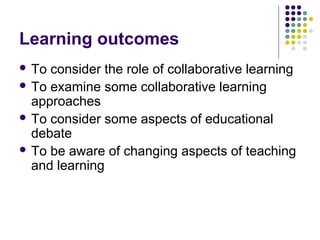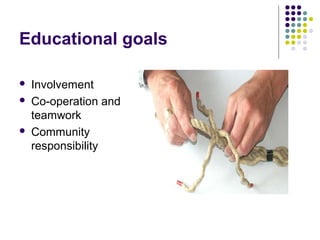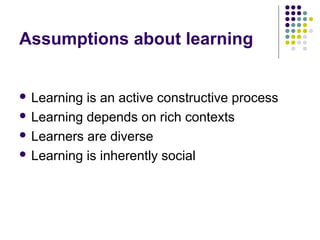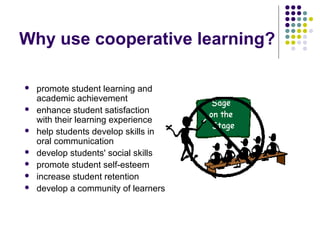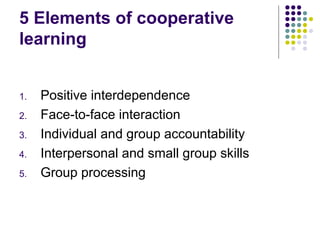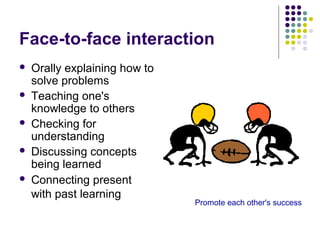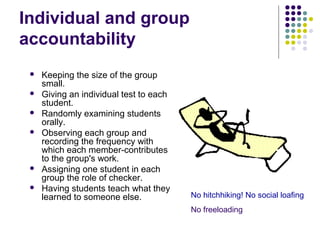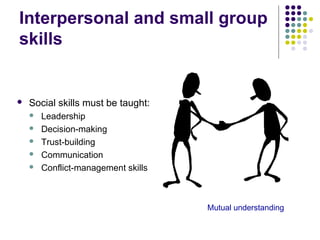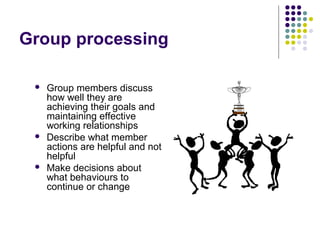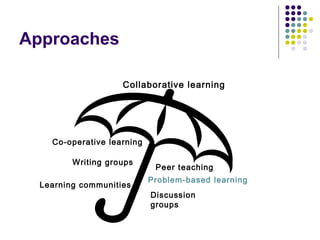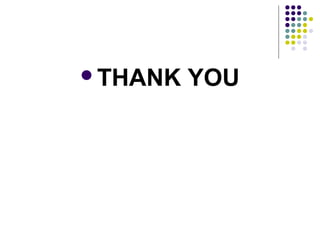Collaborative learning (1)
- 1. Collaborative learning “Collaborative learning is an umbrella term for a variety of educational approaches involving joint intellectual effort by students, or students and teachers together. Usually students are working in groups of two or more, mutually searching for understanding, solutions or meanings, or creating a product.
- 2. Learning outcomes To consider the role of collaborative learning To examine some collaborative learning approaches To consider some aspects of educational debate To be aware of changing aspects of teaching and learning
- 3. Educational goals Involvement Co-operation and teamwork Community responsibility
- 4. Assumptions about learning Learning is an active constructive process Learning depends on rich contexts Learners are diverse Learning is inherently social
- 5. Approaches Collaborative learning Co-operative learning Problem-based learning Writing groups Peer teaching Learning communities Discussion groups
- 6. Why use cooperative learning? promote student learning and academic achievement enhance student satisfaction with their learning experience help students develop skills in oral communication develop students' social skills promote student self-esteem increase student retention develop a community of learners
- 7. 5 Elements of cooperative learning 1. Positive interdependence 2. Face-to-face interaction 3. Individual and group accountability 4. Interpersonal and small group skills 5. Group processing
- 8. Postive interdependence Each group member's efforts are required and indispensable for group success Each group member has a unique contribution to make to the joint effort because of his or her resources and/or role and task responsibilities Sink or swim together!
- 9. Face-to-face interaction Orally explaining how to solve problems Teaching one's knowledge to others Checking for understanding Discussing concepts being learned Connecting present with past learning Promote each other's success
- 10. Individual and group accountability Keeping the size of the group small. Giving an individual test to each student. Randomly examining students orally. Observing each group and recording the frequency with which each member-contributes to the group's work. Assigning one student in each group the role of checker. Having students teach what they learned to someone else. No hitchhiking! No social loafing No freeloading
- 11. Interpersonal and small group skills Social skills must be taught: Leadership Decision-making Trust-building Communication Conflict-management skills Mutual understanding
- 12. Group processing Group members discuss how well they are achieving their goals and maintaining effective working relationships Describe what member actions are helpful and not helpful Make decisions about what behaviours to continue or change
- 13. Approaches Collaborative learning Co-operative learning Problem-based learning Writing groups Peer teaching Learning communities Discussion groups
- 14. THANK YOU
Editor's Notes
- Collaborative learning represents a significant shift away from the typical teacher-centred or lecture-centred milieu in higher education class rooms. In collaborative classrooms, the lecturing/listening/note-taking does not disappear but it lives alongside other processes that are based on students’ discussion and active work with the course material. Lecturers who use collaborative learning approaches tend to think of themselves less as experts transmitters of knowledge and more as coaches or midwives of a more emergent learning process. The process is based on establishing a community of learners.
- Since we use collaborative learning to help students learn more effectively it is important to consider teaching strategies that go beyond a mere mastery of content and ideas. Collaborative learning promotes and educational agenda that encompasses several intertwined rationales Involvement – by its very nature collaborative learning is both socially and intellectually involving. Research has shown that it makes a significant difference in student performance and subsequently student retention. Cooperation and teamwork – In collaborative activities students inevitably encounter difference and have to work to recognise and deal with it. This helps build a community of learners. Community – Habits of participation and responsibility to a subject/classroom community can help in the broader communities. Collaborative learning encourages students to develop an active voice in shaping their ideas and values and also developing a sensitive ear to the views and opinions of thers. In the hands of an expert rope maker loose strands can be skilfully woven together to form a rope with greater strength and durability. The same can be said of a committed and creative lecturer. Don’t get me wrong – there will be cynics – one colleague in another institution- was undertaking collaborative learning in the form of group work when his Dean called and said, “I see you’re doing group work, I’ll call back when you’re teaching!”
- Active constructive process – to learn new information, ideas or skills students have to work actively with them in purposeful ways. In collaborative learning situations students are creating something new by integrating the new material with something they already know or use it to reorganise what they thought they knew. Rich contexts – the idea of collaborative learning activities is to immerse students in challenging tasks or questions. Rather than beginning with facts and ideas and then moving to applications CL activities frequently begin with problems This changes the role of the student from distant observer to practitioner. Rich context challenge students to practice and develop higher-order reasoning and problem-solving skills. Diversity – Our students bring multiple perspectives to the classroom – diverse backgrounds, learning styles, experiences and aspirations. Ashby's Law of requisite variety. Inherent sociability- collaborative learning produces intellectual synergy of many minds coming to bear on a problem and the social stimulation of mutual engagement of mutual engagement in a common endeavour (Voltaire – there is no problem a meeting of minds cannot resolve)
- Cooperative efforts result in participants striving for mutual benefit so that all group members: gain from each other's efforts. (Your success benefits me and my success benefits you.) recognize that all group members share a common fate. (We all sink or swim together here.) know that one's performance is mutually caused by oneself and one's team members. (We can not do it without you.) feel proud and jointly celebrate when a group member is recognized for achievement. (We all congratulate you on your accomplishment!).
- We might need to be aware of Tuckman’s 4 or is it 5 stages of group formation:- Forming Storming Norming Performing Mourning
- The teacher acts as facilitator, encourages positive interaction and commends achievement The group members create dynamics, per responsibility and a combined outcome that is greater than the sum of individual outcomes.

